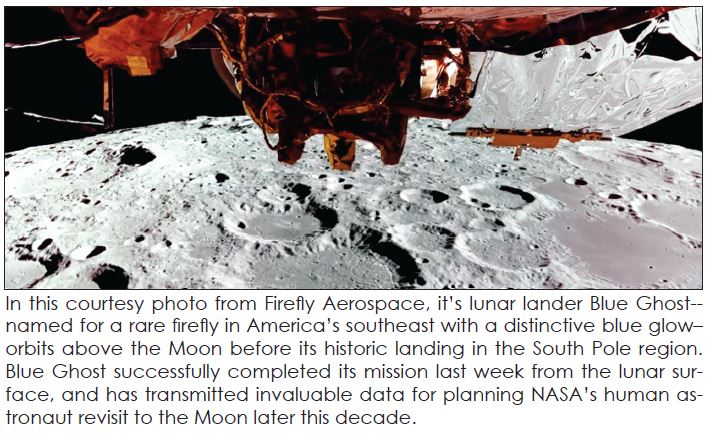
Celestial Exploring again has to pick and choose from the myriad cosmic news items recorded over the last week. We’ll do some highlights and trust our readers can catch up on additional matters from other reliable sources.
Of course, a lot of our attention was drawn last week to the long-anticipated return of US exploring astronauts Suni Williams and Butch Wilmore from the International Space Station. (And no, Elon, they were not “abandoned” there; they were willing ISS residents due to a failed return vehicle nine months ago, simply awaiting, while fully engaged in spacewalks, observations, and experiments, their eventual safe ride home on your next available Space X.) Apparently the Gulf of Mexico splashdown off the west coast of Florida on March 18 was the most widely watched and replayed NASA event ever.
Among other significant events was the Webb Space Telescope yet again observing and imaging some far distant celestial objects that are affecting current space science understandings. The findings were confirmed by Chile’s high desert ALMA observatory. The stunning revelations of oxygen and heavy metal elements inside the most distant confirmed galaxy ever sighted indicates that in the early life of the newborn universe, galaxy formation matured more quickly than theorized. As often noted here, as observation expands, knowledge and understanding are reshaped.
The galaxy, known as JADES-GS-214-O, is 13.4 billion light years away, having been formed some few million years after the Big Bang. These types of early galaxies are supposed to be found with lighter elements and dimmer appearance, but not so with JADES. There will need to be further research with similar confirmations before a new early galaxy formation model is proposed. JADES is to date the only one of the 700 galaxies Webb is staring at that has evidenced such an unexpected makeup. International teams of researchers are already engaged with the exploratory task.
Quite closer to home at about six light years away, Barnard’s Star, a red dwarf catalogued as GJ 699, is visible only by telescope in the southern sky Hercules family of constellations: Ophiuclus, or Snake Bearer (cf., constellation-guide.com). It is the fourth closest star to Earth, preceded only by three components in the Alpha Centauri system. Bearing the name of “E. E.” (Edward Emerson) Barnard, who plotted its precise motion in 1916, the star is thought to be one of the oldest in the Milky Way, at about ten billion years. It came into prominence recently because astronomers have discovered it has four orbiting planets, varying from 0.19 to 0.34 Earth masses; none of them are in a habitable zone, and most likely have no water or atmosphere. Nonetheless. the finding enhances our understanding of other worlds, planet formation and evolution.
Even closer to home, as close as it gets, a commercial lunar lander, Blue Ghost, developed by Texas company Firefly Aerospace, successfully completed its 14-day mission from our Moon’s south pole. It carried ten NASA research programs and has conveyed 120 gigabytes of data –one commentator noted that is the equivalent “of about 24,000 songs”—that will help planning for sending humans back to the Moon later this decade (if funded). Summarizing the purpose of the mission, before it blinked out Sunday, March 16, the automated Blue Ghost transmitted a final message: it was going to “hold vigil…to watch humanity’s continued journey to the stars.” NASA envisages the Moon as a launch pad for further space exploration missions.
As for our Valley’s stargazers, we are unfortunately out of range of view for the year’s first partial solar eclipse on Saturday. The event will be visible in the northeastern US, Canada, and parts of Europe. Your favorite sky guide will carry the progression of the event, so local viewers will have an opportunity to follow and revisit the partial eclipse.
In the meantime, our first official week of Spring has had its usual fits and starts, but we’re used to that, and celebrate winter’s official passage, even though we’ll undoubtedly have lingering winter weather for a time. Mother’s Day is our household mark for Spring!
Happy viewing!
– W.A. Ewing
